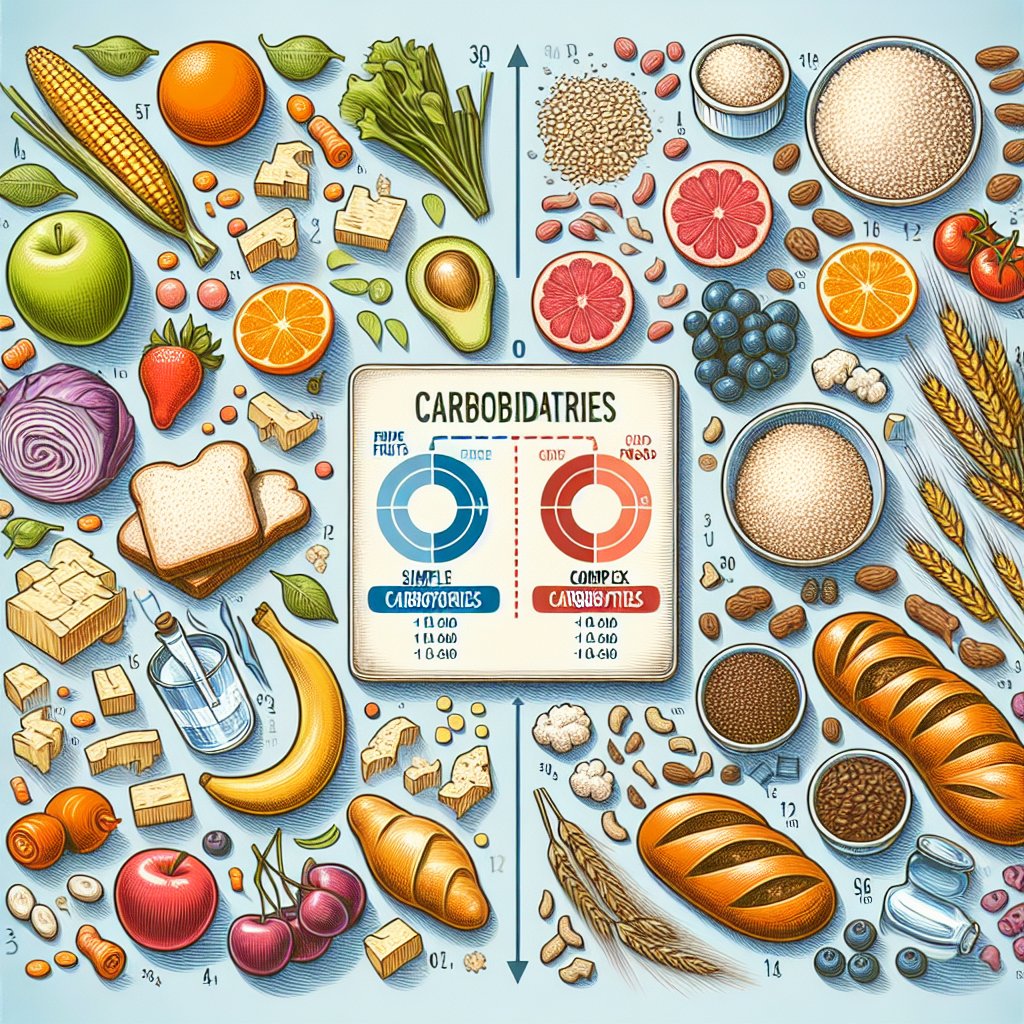Unlocking Ketogenic Success: How to Read Carbs for Keto and Master Your Diet
Understanding Carbohydrates on a Ketogenic Diet
Welcome, keto warriors! Today, let’s dive into a crucial aspect of our high-fat, low-carb lifestyle – understanding carbohydrates. If you’re on the ketogenic diet, you know that mastering your carb intake is key to unlocking success. But why is this understanding so important? Well, carbs directly impact your body’s ability to stay in ketosis, the state where it burns fat for fuel instead of carbs. By learning to read carbs for keto, you can take control of your diet, boost your energy, and maximize your weight loss efforts. Let’s unravel the mystery of carbs and discover how to navigate them like a pro!

What are Carbohydrates?
Carbohydrates are one of the three main macronutrients, along with proteins and fats. They serve as the body’s primary source of energy, fueling various cellular functions and physical activities. When consumed, carbohydrates are broken down into glucose, which is then used by the body as a quick source of energy. However, not all carbohydrates are created equal, especially when it comes to the ketogenic diet. Understanding how to read carbs for keto is crucial for mastering your diet and achieving ketosis.
Research has shown that the body’s energy production process heavily relies on the presence of carbohydrates. A study published in the “Journal of the International Society of Sports Nutrition” highlighted that consuming carbohydrates before and during prolonged, continuous, and intense exercise can enhance endurance performance by maintaining blood glucose levels and high rates of carbohydrate oxidation, ultimately delaying the onset of fatigue.
Types of Carbohydrates
Understanding the different types of carbohydrates is crucial for success on a ketogenic diet. Carbs can be broadly classified into two main categories: simple carbohydrates and complex carbohydrates.
Simple Carbohydrates (Sugars)
Simple carbohydrates, often referred to as sugars, are composed of one or two sugar units. They are quickly digested and absorbed into the bloodstream, leading to rapid spikes in blood sugar and insulin levels. Foods high in simple carbs include table sugar, honey, fruit juices, and refined grains like white bread and pasta.
Complex Carbohydrates (Fiber, Starch)
Complex carbohydrates are made up of longer chains of sugar molecules, which take longer to break down. This gradual digestion leads to a slower and more sustained release of sugar into the bloodstream, helping to maintain steady energy levels. Foods rich in complex carbs include vegetables, legumes, whole grains, and starchy vegetables like sweet potatoes.
Carbohydrates and the Ketogenic Diet
When it comes to achieving success on a ketogenic diet, monitoring your carb intake is key. The significance of carefully managing your carb consumption cannot be overstated. Research shows that keeping a close watch on your carb intake is crucial for reaching and maintaining a state of ketosis, where your body burns fat for fuel instead of carbohydrates.
According to a study published in The American Journal of Clinical Nutrition, restricting carb intake to around 20-50 grams per day can lead to the production of ketone bodies, which are an alternative fuel source for the body. This metabolic state not only aids in weight loss but also offers various health benefits, including improved insulin sensitivity and increased mental clarity.
By understanding how to read carbs for keto, individuals can make informed choices about their food consumption and optimize their chances of entering and staying in ketosis. This means paying attention to not just the total carb count, but also the type of carbs consumed, as certain types may have a different impact on blood sugar levels and ketosis. Armed with this knowledge, anyone embarking on a ketogenic journey can navigate their way to success with confidence.

Reading Carbohydrate Labels
When it comes to following a ketogenic diet, understanding how to accurately read nutrition labels to determine carb content is key. It can be a game-changer in your keto journey. Let’s break it down to make it easy for you.
First, familiarize yourself with serving sizes. The nutrition information on the label is based on one serving, so if you eat more than this amount, you’ll need to adjust the carb count accordingly.
Next, check the total carbohydrates, which include sugars, fiber, and other forms of carbohydrates. Be mindful of the fiber content as it can be subtracted from the total carbs to get the net carbs, which is what really matters on keto.
Look out for sneaky hidden carbs in ingredients like maltitol, dextrose, and other sugar alcohols. While they may have less impact on blood sugar, they can still affect ketosis for some individuals.
By mastering the skill of reading carbohydrate labels accurately, you can make informed choices and stay on track with your keto lifestyle.
Hidden Carbs to Watch Out for
When following a ketogenic diet, it’s essential to be mindful of hidden carbs lurking in seemingly innocent foods. Some common culprits include sauces, condiments, and flavored yogurts. These items often contain added sugars and can derail your keto efforts.
To read carbs for keto, always check the nutrition labels for total carbohydrates and fiber. Remember to subtract the fiber content from the total carbs to calculate the net carbs, which is the number that truly impacts your ketosis. This simple calculation can help you make informed choices about which foods to include in your diet and which to avoid.
By staying vigilant and learning to identify these hidden carbs, you can confidently navigate your ketogenic journey and maximize your chances of success.
Calculating Net Carbs
One of the key concepts to grasp when following a ketogenic diet is the idea of net carbs. So, what are net carbs and how are they calculated? Simply put, net carbs are the carbohydrates that are absorbed by the body. To calculate the net carbs in a food item, you subtract the fiber and sugar alcohols (if any) from the total carbohydrates. The rationale behind this is that fiber and sugar alcohols have minimal impact on blood sugar levels, and therefore, do not hinder the state of ketosis.
For instance, if a food item contains 15 grams of total carbohydrates, 6 grams of fiber, and 2 grams of sugar alcohols, the net carbs would be calculated as 15g – 6g (fiber) – 2g (sugar alcohols) = 7 grams of net carbs. This 7 grams is what really matters on a ketogenic diet because it is the portion of carbohydrates that will affect your blood sugar levels and, ultimately, your body’s ability to stay in ketosis.
Understanding the concept of net carbs empowers you to make informed choices about the foods you consume, helping you to stay within your daily carb limit and achieve success on your ketogenic journey.

Impact of Carbohydrates on Ketosis
When it comes to the ketogenic diet, the impact of carbohydrates on ketosis and overall success is crucial to understand. The level of carbs in your diet can significantly affect your body’s ability to enter and maintain ketosis.
Research shows that different carb levels can have varying effects on ketosis. For most people, consuming 20-50 grams of net carbs per day is the optimal range to achieve and sustain ketosis. However, some individuals may need to consume fewer than 20 grams of net carbs to reach this metabolic state effectively.
It’s important to note that the type of carbohydrates consumed also plays a role. Fibrous, non-starchy vegetables are encouraged, as they have minimal impact on blood sugar and insulin levels, whereas refined and processed carbs can hinder ketosis and overall success on a ketogenic diet.
Understanding and carefully monitoring your carb intake is essential to unlocking ketogenic success and mastering your diet.
Now, let’s delve deeper into identifying the right carbs for a successful ketogenic journey.
Practical Tips for Managing Carbohydrate Intake
Successfully navigating the ketogenic diet hinges on mastering the art of controlling carbohydrate consumption. Here are some practical tips and strategies to help you stay on track:
1. Read Food Labels Carefully
When following a keto diet, every gram of carbs matters. Pay close attention to food labels and look for hidden sources of carbohydrates, such as added sugars and starches.
2. Focus on Fiber-Rich Foods
Incorporate plenty of fiber-rich vegetables like broccoli, cauliflower, and spinach into your meals. Not only are these low in net carbs, but they also help you feel fuller for longer.
3. Select Low-Glycemic Index Foods
Opt for foods with a low glycemic index, as they have a minor impact on blood sugar levels. This includes leafy greens, avocados, and berries.
By carefully monitoring food labels, prioritizing fiber-rich and low-glycemic index foods, you can easily manage your carbohydrate intake and stay in ketosis.
Conclusion
In conclusion, reading carbs for keto is crucial for achieving success on the ketogenic diet. By understanding the concept of net carbs and its impact on blood sugar and ketosis, you can make informed choices about the foods you consume. Remember, not all carbs are created equal, and focusing on high-fiber, nutrient-dense sources can support your overall health while keeping you in ketosis. Always prioritize whole, unprocessed foods and use tools like food labels and carb-tracking apps to stay on track. With a clear understanding of reading carbs for keto, you are well-equipped to make the right choices and master your ketogenic journey for long-term success.


